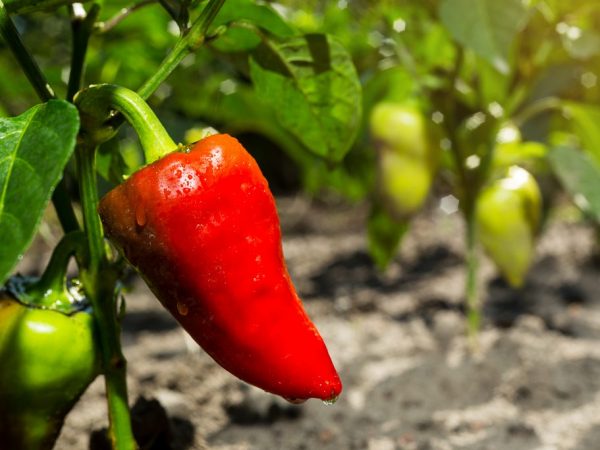Characteristics of the Pride of Russia pepper variety
Pepper Pride of Russia is one of the most fruitful sweet varieties. It perfectly retains its qualities for a long time after collection. We will consider a detailed description of the variety in the article.

Characteristics of the Pride of Russia pepper variety
Characteristics of the variety
Early maturing variety. It starts bearing fruit from about 100-104 days after germination. With quality care, you can harvest high quality crops until mid-October. And its volumes will pleasantly surprise you:
- In greenhouse conditions up to 15 kg per 1 sq. m;
- On an open area - 8-9kg per sq. m.
Also, Pride of Russia is resistant to many diseases. has reliable immunity.
Description of the bush
The bush is rather compact, does not grow higher than 50 cm. One bush can have up to 20 fruits. Their average weight is about 150g. Although this culture is thermophilic, with a strong abundance of high temperatures, foliage and flowering of the ovary can begin to fall off.
Description of the fetus
Depending on the degree of maturity, the fruit changes its color throughout the entire growth period. Initial light green to deep red at ripening. The flesh of the fruit is rather thick, it can reach 7mm. Thanks to this, the fruit is quite juicy, stores a lot of vitamins. The shape resembles a narrow elongated prism. Pepper of Russia is ideal for both processing and fresh consumption.
Care
This variety can be grown outdoors and in a greenhouse. The greenhouse needs to be constantly ventilated, and in hot summers it is worth keeping it open all the time.
Seedling
Before planting peppers, you need to prepare the seedlings. It is recommended to do this 60 days before disembarkation (late February-early March).
The optimum temperature for seed germination will be 25-28 degrees with average humidity. To do this, wrap the seeds in a damp cloth and put them on a saucer, covered with plastic, but leaving a little air so that there is no puddle. After a couple of days, when sprouts appear, it is worth planting the seeds in the potting mix in a small container with a distance of 2 cm between each seed. Or in separate cups or molds without picking. Important conditions for further germination are:
- good illumination for about 10 hours a day;
- watering with water at room temperature.
The appearance of the first buds will mean that the seedlings are ready to be transplanted to the site.
The soil

Keep a distance when landing
For planting in the spring, it is worth preparing the soil in the fall by digging it up and adding organic fertilizers. Plant seedlings in small holes so that 1sq. m accounted for 5-7 bushes.
Watering
It is worth watering 3-4 times a week in the morning or in the evening, depending on external weather conditions. The main condition is careful watering at the root, so that the plant does not lose stability and does not break.
Loosening
It is necessary to break up the soil so that it does not become crusty. It will also prevent weeds from interfering with the normal growth of the pepper. Loosening is worth no more than a couple of times a week.You need to loosen it extremely carefully so as not to touch the foliage and trunk.
Top dressing
It should start from the period of the appearance of the ovary and before the formation of fruits. The pride of Russia will be enough for pepper one or two additional dressings per month. It is preferable to apply mineral and organic fertilizers. They need to be poured under the bush so as not to hurt the leaves, so that the roots receive all the necessary substances.
Diseases and pests
The most effective ways to prevent disease are:
- Choose seeds for planting only healthy plants.
- Before sowing, the seeds should be kept in a solution of potassium permanganate for 20 minutes and then rinsed thoroughly - this will provide an antibacterial effect.
- Do not plant seedlings where potatoes and tomatoes have grown.
Diseases
If left untimely, the disease can overcome the plant. The most common diseases and their treatment:
- Fusarium pepper is a fungal disease. The diseased plant should be removed from the garden and the soil should be loosened. Watering should be reduced.
- Late blight - dark spots on fruits. Treatment with chemicals.
- Black leg - root rot due to excess moisture. It is necessary to loosen the ground around the plant and sprinkle with wood ash. Also adjust the frequency of watering.
- Bronze pepper (or spotted wilting) is a foliar disease in which the color changes to bronze to dark purple. It is worth immediately chemically treating and collecting the fruits. Stop watering.
- Top rot - the fruit rots right during growth. This is due to a lack of moisture. You can spray with calcium nitrate and water the plant abundantly.
Pests
- For aphids, use a water solution of ash or tobacco dust.
- Sprinkle the soil 3 times a day with quicklime against slugs.
- The most common pest is the Colorado potato beetle. The best way to deal with them is with chemical sprays.
- You can use naphthalene or kerosene from the bear, scaring them off with a smell.
- When fighting whiteflies, you can simply pour water on the foliage in order to wash off the insect, and then loosen the soil and cover it with peat or humus into a layer of 2 cm.
Conclusion
Pepper Pride of Russia is very often chosen by gardeners for cultivation, since the variety is distinguished by its early maturity and unpretentious care.


